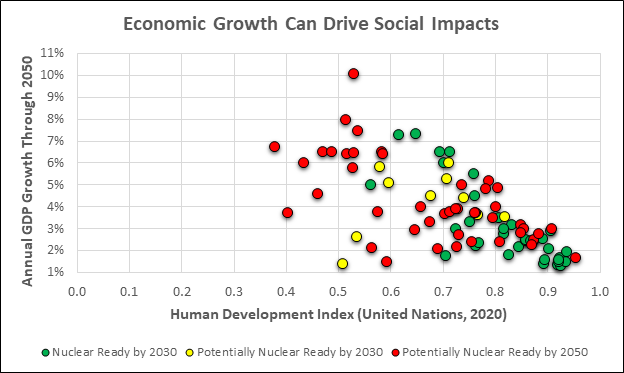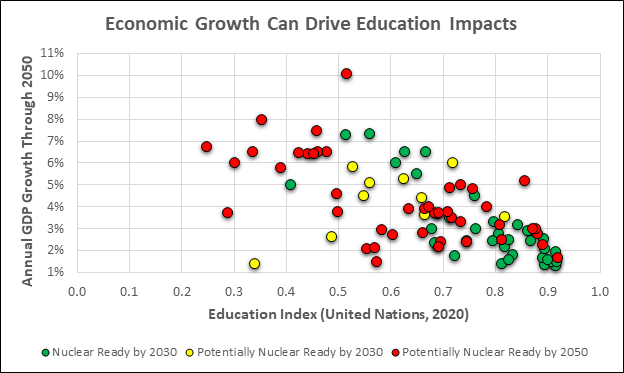Renewable and Nuclear Energy Integration to Support Responsible Growth In Developing Countries
Part 2: Social Impacts and Implications
Last month, I posted the first of a few articles that will consider the responsible integration of renewable and nuclear generation to foster economic, social, and security improvements. The first article can be found here. In this second article, I wanted to shift towards the positive social implications from expanding generation assets in a responsible manner to support not just the aforementioned economic development but also long-term social benefits.
For developing countries (especially in Africa and Asia), central planning organizations have the perfect opportunity to develop long-range plans for key infrastructure expansion (notably in the energy sector) while simultaneously improving the quality of life for their citizens. Creating an effective long-term and fiscally responsible diversified energy plan using wind, solar, hydro, and nuclear power can help improve their social and education systems and support their development needs with the latest technology advances driving modern life in the 21st century.
Multi-Criteria Decision-Making
Ultimately, a key question is how countries evaluate and decide their diversification strategy for power generation. There are numerous options available but ultimately, the electricity grid must be capable of handling and synthesizing widely varying and diverse technologies in a stable, neutral, and independent manner to ensure stability and reliability. For that reason, multicriteria decision making approaches (MCDA) have gained favour, with various amalgamations of tools and criteria specific to the circumstances.
In focusing on the creation of an appropriate electricity generation portfolio, a frequent grouping of primary criteria includes:
- Economic,
- Social,
- Energy Security,
- Environmental, and
- Technical
Due to the possible extensive domestic impacts of the energy sector, below each of these criteria will be a variety of country-specific sub-criteria with inputs from experts in the academic, industrial, political, commercial, environmental, and other sectors that provide inputs to national decision-making policies. With a finite amount of money to expand power generation, the synthesis of competing qualitative and quantitative data (a key benefit of MCDA) should help focus governments developing an appropriate generation expansion plan.
Potential countries that could use a mix of wind, solar, hydro, and nuclear will need to decide how to evaluate, prioritize, balance, and assess each of the above (sub) criteria. This will likely include developing and reviewing a process overseen by some “expert panel” to synthesize the wide variety of inputs and variables into a series of workable conclusions and actions.
In literature reviews from around the world, economic criteria universally rank as the primary considerations in developing new electricity generation plans. What can country X afford? How will it be financed? What type of generation should be built? What ownership and operation models are most advantageous? What type of support infrastructure is required? Do they have the financial resources now (and in the future) to build new generation and then operate it?
The primary larger scale options for non-emitting generation by 2021 include wind, solar, hydro, and nuclear with all being relatively established technologically but nuclear clearly requiring the largest support infrastructure based on the higher complexity. The previously-discussed report by American thinktank Third Way published in September 2020 considers which countries may be capable of operating nuclear power plants by 2050. Using the same groupings (see my previous article here), we want to consider how those countries could potentially look at all four options and consider decision-making between possible wind, solar, hydro, and nuclear generation expansion.
The first post focused on the broad economic necessity for increased electricity generation to support major population and economic (GDP) growth projections through 2050. The average 2050 population and electricity growth projection rates in the Nuclear Potentially Ready by 2030 and 2050 categories FAR exceed those for Ready by 2030 countries. So, while the Ready by 2030 countries may have larger cumulative growth, the rates are substantially lower than the other two categories because the Ready by 2030 group is starting at much higher initial levels.
Driving Social Impacts
As noted through the criteria above though, centrally planned energy development should not only support economic development but broader social, security, and environmental goals. But practically speaking, what type of social support could and should power generation provide to society as a whole? By developing the energy sector, what additional industries should feel the impact most astutely – education, healthcare, technology, media, etc.?
The United Nations (UN) created the Human Development Index (HDI) as a means to assess the development of a country beyond economic growth alone. As such, it is a quantitative measure to evaluate: 1) a long and healthy life, 2) knowledge, and 3) a decent standard of living. While acknowledging certain limitations with this index, it nevertheless provides a reasonable starting place for countries looking to develop a cohesive and comprehensive generation plan that can easily have impacts far beyond the 2050 used in the graphs.
Using the HDI data, and comparing it with the projected GDP growth through 2050, results are in a chart below:

Figure 1: GDP Growth vs Human Development Index (consolidated from: Mapping the Global Market for Advanced Nuclear – Third Way, Human Development Index (HDI) | Human Development Reports (undp.org)
The graph above clearly shows that countries Ready by 2030 (green dots in the graph) generally trend toward a higher HDI – they are more developed today and their citizens enjoy longer lives, higher standards of living, and are usually more educated. So, while the yellow and red circles (indicating Potentially Ready by 2030 and 2050 respectively) may show higher GDP growth rate opportunities, a central planning organization should also be driving to move their circles to the right and improve their citizens lives and well-being.
Social improvements will have far-reaching impacts that far exceed the energy and generation industry. Domestic improvements in core infrastructure will follow and result in growth areas previously not considered. A more dependable electricity grid will support improved healthcare, better care and capabilities at hospitals and clinics. Broader electrification will allow children the ability to study more beyond sunlight hours and decrease dependency on expensive kerosene lamps; this will meaningfully result in improved education options for children which becomes a virtuous positive cycle. Desalination plant expansion can lead to improved drinking water for citizens, improving overall health. Manufacturing and advanced industries can expand if supported by reliable power sources and trained personnel. Large multinational corporations evaluating investments will positively view stable electric systems supported by an educated, well-trained population. And a driving force supporting all of this should be an expanding education system as the basis for advanced education and training.
Social Implications Driving Education
The graph below focuses only on the Education Index component as part of the HDI.

Figure 2: GDP Growth vs. Education Index (consolidated from: Mapping the Global Market for Advanced Nuclear – Third Way, Human Development Index (HDI) | Human Development Reports (undp.org)
The Education Index is measured by the mean years of schooling for adults 25+ and the expected years of school for children entering school that year. Assuming that higher levels of education will improve overall quality of life and fuel future economic growth, policymakers should plan accordingly to move their countries further to the right in the graph above.
So how can a robust, well-conceived power generation plan affect social improvement? The planning, design, construction, and operation of energy generation plants requires well-educated individuals typically well-schooled in the science, technology, engineering, and mathematics (STEM) disciplines. Of course, this work could be outsourced in theory but why would a country voluntarily send their money outside their borders when they could practically use it for the long-term betterment of their citizens? Instead, money could and should be invested in developing domestic education programs focused on needs to support 100 years of energy production – the potential system life cycles for nuclear and hydro plants while solar and wind are substantially shorter (20+ years).
Skills learned through expanded STEM education will be translatable to numerous infrastructure and industrial applications such as desalination plants, hydrogen production facilities, manufacturing facilities, industrial complexes, thermal energy storage systems, battery and chemical storage systems, etc. As the education system upgrades, the benefits will sustain the continued growth for many years to come. But without the education system in place, social challenges are likely to continue and money will exit a country via outsourcing to support higher technology work that should rightfully be returning to citizens.
The education system should not just focus on university matriculation – there will be a tremendous need for technical and vocational education and training (TVET). Strong STEM education in the younger years will lead to both college-educated personnel and the equally important trade skills that are vital to construction, operation, and decommissioning of complex large projects. There will be tremendous opportunities for welders, mechanics, carpenters, boilermakers, plumbers, pipefitters, ironworkers, masons, etc. Trade schools must develop in parallel.
Already, numerous Ready by 2030 countries in Asia, Europe, and North America have established programs designed to accept and financially support students from developing countries for college education. These students then have the opportunity to receive high-level education which they can bring back to their native country to support development and growth – and future training of subsequent generations. In the U.S., similar programs made the news in mid-2020 when the Trump Administration added new restrictions to the student visa program because of COVID-19, with U.S. universities immediately protesting the changes. These international training programs support the growth and improvement of education systems that have a long-term positive affect in the home countries.
For any generation plant, education is a key factor. Wind and solar plants have far more employment opportunities during the design and construction phases than they do once plants are operational. Since wind and solar plants only have infrequent planned maintenance, trained personnel have limited long-term employment options unless there is a steady supply of construction opportunities. From a social improvement perspective, wind and solar are more limited over their lifecycle in comparison to nuclear plants which can provide hundreds of well-paying generational jobs for 80-100 years per site. One non-emitting generation type is not the answer – it must be a combination.
This diversification (similar to money investing) will have the greatest long-term social impact by spreading the benefits across more people and making the system self-sufficient.
What’s Next?
Social and economic criteria are obviously two very important factors but there is another major factor interspersed through all the criteria – energy security. The drive to avoid undue dependence on a foreign energy source(s) has driven policy decisions for many years/centuries. Next, we will look at the challenges these same countries have balancing their energy independence and security with the desire to increase non-emitting generation sources. Stay tuned!
John Valentino is the International Clients Director at Centrus Energy and graduate of ESCP Business School’s Executive Master in Energy Management (Class of 2019).
The views and opinions expressed in this article are those of the author and do not necessarily reflect the position of ESCP Business School.









 Facebook
Facebook Linkedin
Linkedin Instagram
Instagram Youtube
Youtube EMC Newsletter
EMC Newsletter







